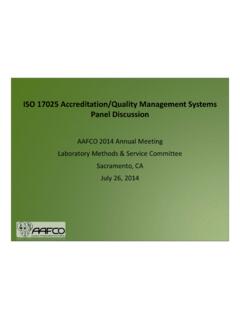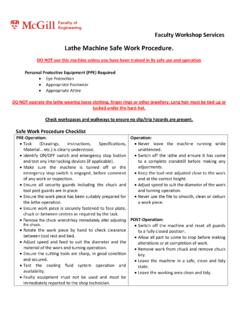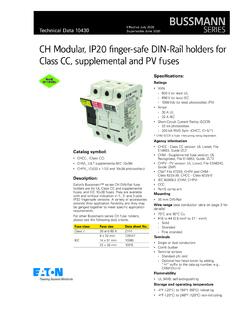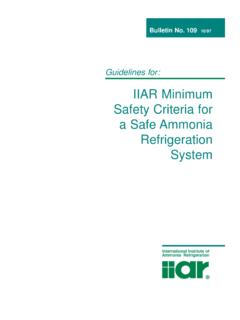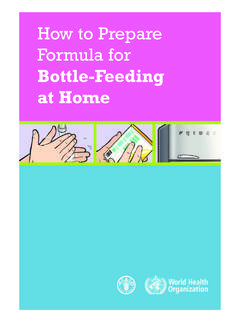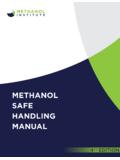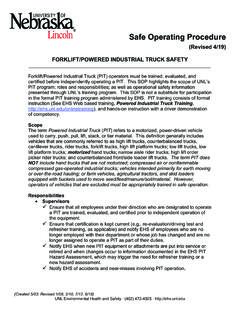Transcription of Animal Feed Labeling Guide - AAFCO
1 Animal feed Labeling Guide Association of American feed Control Officials ( AAFCO ). Medicated Feeds, Pet Food and Specialty Pet Labels have Additional Requirements. For information on pet food and specialty pet labels, purchase the AAFCO Pet Food and Specialty Pet food Labeling Guide at org/publications August 2020. CONTENTS. Introduction .. 1. Acronyms and Abbreviations.. 2. Label Design and Required Elements .. 3. Commercial feed Labels.. 3. Single Ingredient Product Labels.. 3. Customer Formula feed Labels.. 4. Label Formatting for Commercial Feeds .. 4. Product & Brand Names.. 4. Purpose Statement .. 5. Guaranteed Analysis .. 5. When to State Guarantees.. 5. How to Express Guarantees .. 8. Species-Specific Feeds and Supplements.. 10. Mineral Feeds.. 15. Ingredient Statement.. 17. Collective Terms .. 18. Directions for Use and Precautionary Statements.
2 18. Manufacturer or Distributor Name.. 19. Net Quantity Statement.. 20. Non-Medicated feed Label Examples .. 20. Commercial feed Labeling .. 21. Single Ingredient Labeling .. 37. Customer Formula feed Labeling .. 38. Association of American feed Control Officials ( AAFCO ). Headquarters Office 1800 S. Oak Street, Suite 100. Champaign, IL 61820-6974. 217-356-4221. August 2020. August 2020. INTRODUCTION. The Association of American feed Control Officials ( AAFCO ) is a voluntary membership organization that comprises personnel representing state and federal feed regulatory agencies. The Association is advised by industry and consumer representatives with the intent of designing feed regulations that provide fair and equitable commerce for all stakeholders. A major function of feed regulation is to safeguard the health of man and animals and a critical component of that function is to ensure that Animal feed and feed ingredients are appropriately and safely used as provided by the product label.
3 This booklet will provide you with the necessary basic information and guidelines so you can design and produce commercial non-medicated feed labels that meet the AAFCO Model Bill and Regulations. Labels addressed in this Guide are for the various classes of food-producing and livestock Animal non-medicated feeds and specialty product types that are fed to these animals, such as mineral premixes and free-choice feeds, and the Labeling of some feed ingredients. This Guide does not address the Labeling of pet food or specialty pet food. There is a separate Guide available for these products. For more information, please visit Disclaimer About Varying State Requirements Though some state feed regulatory agencies recognize the AAFCO Model Bill and Regulations, there may be additional requirements for feed Labeling compliance that is specific to their own law and regulations.
4 Prior to distributing commercial feeds in any state or territory, consult with the corresponding feed control official. For a contact list of feed control officials, please visit The information included in this Guide is derived from the 2018 AAFCO OP. For complete Labeling information refer to the current edition of the AAFCO OP. To obtain the AAFCO OP. go to the AAFCO web site at or contact Jennifer Roland, by phone: (217) 356-4221 or email: What is the purpose of a feed label? A commercial feed is nutritionally suitable for its intended use as represented by its Labeling . A feed label allows the purchaser to select a product to meet their production needs. A label provides basic product information that would help the purchaser determine how to use the product safely and obtain the best benefits and results. In addition, a label of uniform format and composition provides a level field of play for both the purchaser and distributor.
5 What information is on a feed label? A commercial feed label contains information describing the feed product and details necessary for the safe and effective use of the feed . This includes product name, brand 1. August 2020. name (if applicable), a product purpose statement, levels of nutrients provided, the ingredients used to make the feed , feeding directions (adequate directions for use), cautions and/or warnings, manufacturer/distributor information (the person or firm responsible for the feed ), and net weight of the package, or contents of the container, if applicable. The information that is present on an Animal feed label is based on many factors, such as the intent of the product (single ingredient versus complete ration) or the species to which the product is intended to be fed. In addition, in some cases, dependent on the amount of feed , there may not be a traditional label as you would see printed on, or sewn to, a sack of feed , but perhaps it will be printed on the invoice or delivery slip.
6 Regardless, all the Labeling information discussed in this booklet is needed for the buyer to safely use the feed and must be present. Additionally, the AAFCO Model Bill defines the difference between a commercial feed , feed ingredient , and customer-formula feed , and the necessary label information for these products varies as discussed later in this booklet. ACRONYMS AND ABBREVIATIONS. AAFCO : Association of American feed Control Officials ADF: Acid Detergent Fiber CFR: Code of Federal Regulations CFU: Colony Forming Units FDA: Food and Drug Administration g: gram(s). ICU: International Chick Units IU/lb: International units per pound kg: kilogram(s). l/L: liter(s). lb/lbs: pound(s). mg: milligram(s). ml/mL: milliliter(s). NDF: Neutral Detergent Fiber NPN: Non-protein nitrogen OP: Official Publication oz: ounce(s). ppm: parts per million 2.
7 August 2020. LABEL DESIGN AND REQUIRED ELEMENTS. Commercial feed Labels (See examples of labels on page 21 to page 38). A commercial feed can be a feed ingredient or a combination of feed ingredients which are distributed to be fed to animals. The label for each package or bulk delivery of commercial feed products shall contain all of the following information in this specified order: The product name and its brand name, if any The purpose statement for the feed (identifying specific species and Animal class(es)). The guaranteed analysis statement The ingredient statement Directions for safe and effective use (commonly known as Feeding Directions or Mixing Directions ) and any required precautionary statements to enable the safe use of the product by users with no special knowledge of the purpose and use of the product. The manufacturer's or distributor's name and address A quantity or net weight statement, in both standard (avoirdupois) and metric units Single Ingredient Product Labels (See example on page 37).
8 A single ingredient, other than those exempted by the Model Bill and Regulations, is still considered a commercial feed . However, with all the varieties of ingredients available with a multitude of purposes and uses, it is necessary to provide some information in order to ensure correct Labeling of these products. More information can be found after Commercial feed Label Requirements. The label for each single ingredient feed shall contain all of the following information: The product name and its branded name, if any The purpose statement Single feed Ingredient , feed Ingredient or For Further Manufacturing of feed , as appropriate The guaranteed analysis statement The ingredient statement if the ingredient is not used as the product name Directions for safe and effective use and required precautionary statements, if any The manufacturer's or distributor's name and address A quantity or net weight statement 3.
9 August 2020. Customer Formula feed Labels (See example on page 38). A customer-formula feed is a commercial feed which consists of a mixture of feed ingredients and/or commercial feeds which is manufactured according to the specific instructions of the customer. A customer-formula feed must be accompanied by the information listed below using a label, invoice, delivery ticket, or other shipping document. The label for each delivery of a customer-formula feed shall include: Manufacturer's name and address Purchaser's name and address Date of delivery or sale The customer-formula feed name and brand name, if any The complete name and net quantity of each commercial feed and each other ingredient used in the customer-formula feed Directions for use and precautionary statements, if required LABEL FORMATTING FOR COMMERCIAL FEEDS. These requirements are all expected to be listed on the product's Principal Display Panel , the outward facing side of the feed tag or the portion of the label most likely to be presented and read under the normal conditions of display for retail sale.
10 1. Product & Brand Names (Model Regulation 3(a)(1)). The product or brand name must be appropriate for the feed 's intended use and may not be misleading in any way. If the product name indicates a specific purpose, the feed 's composition must correspond to that (for example, starter, finisher or complete feed ). The name of the feed cannot be comprised of the names of one or more of the ingredients, unless all the ingredients used to make the feed are included in the feed 's name. An ingredient or a combination of ingredients can be used in the product name if it imparts a specific characteristic to the product and that characteristic is significant to the product's purchaser and are quantified by guarantees in the Guaranteed Analysis statement. The word protein cannot be used in the product name if the feed contains any added non-protein nitrogen.
